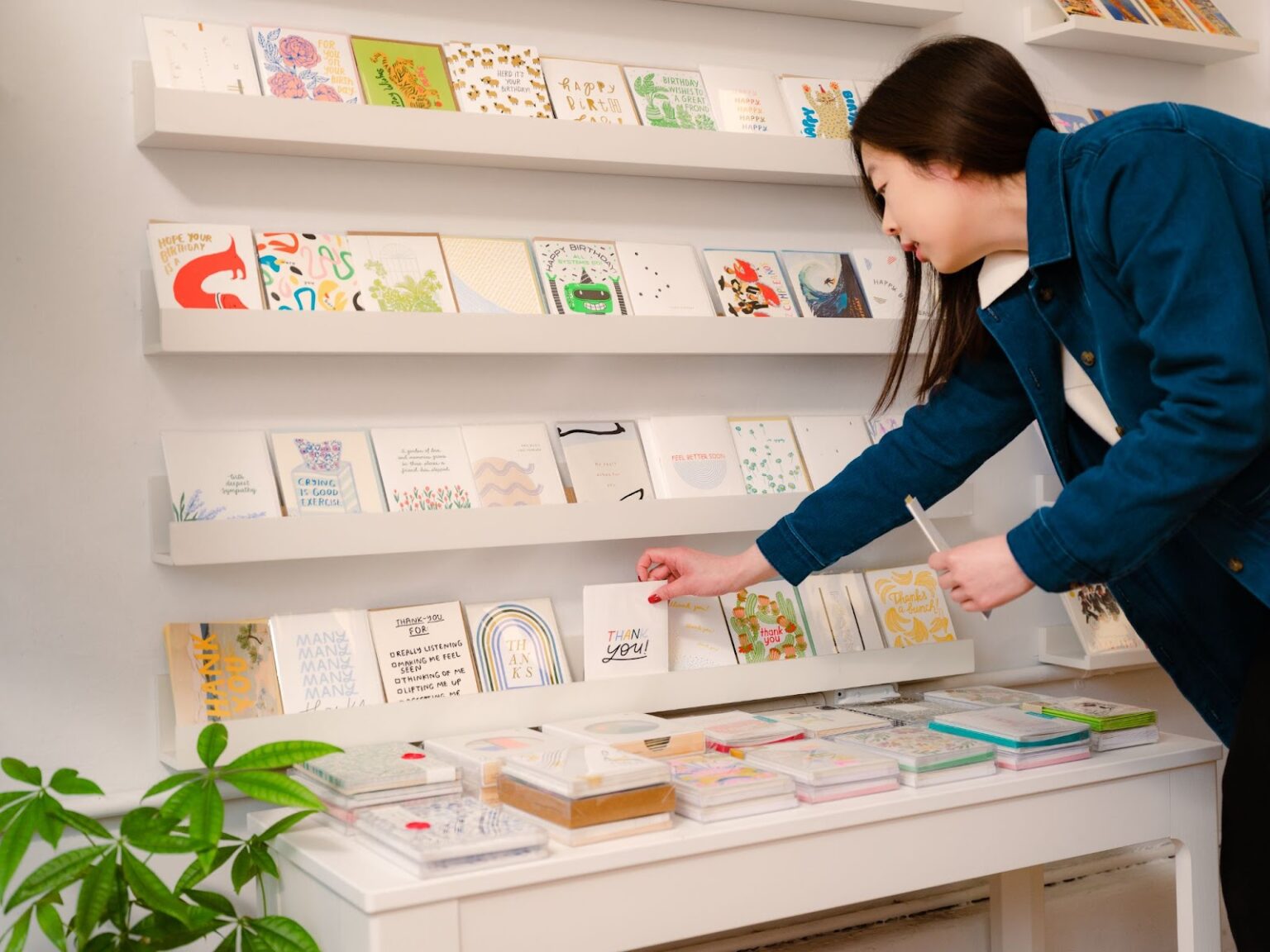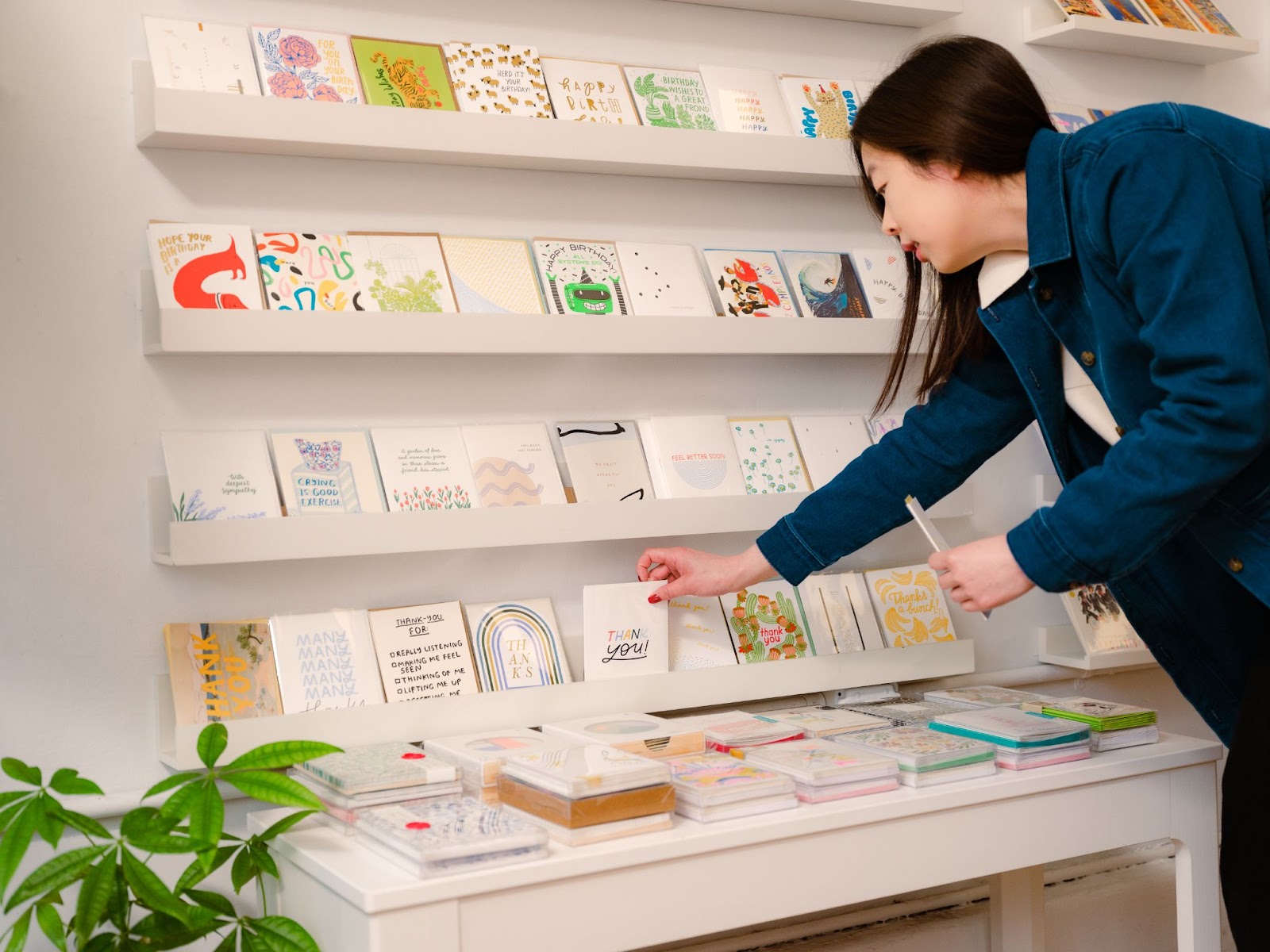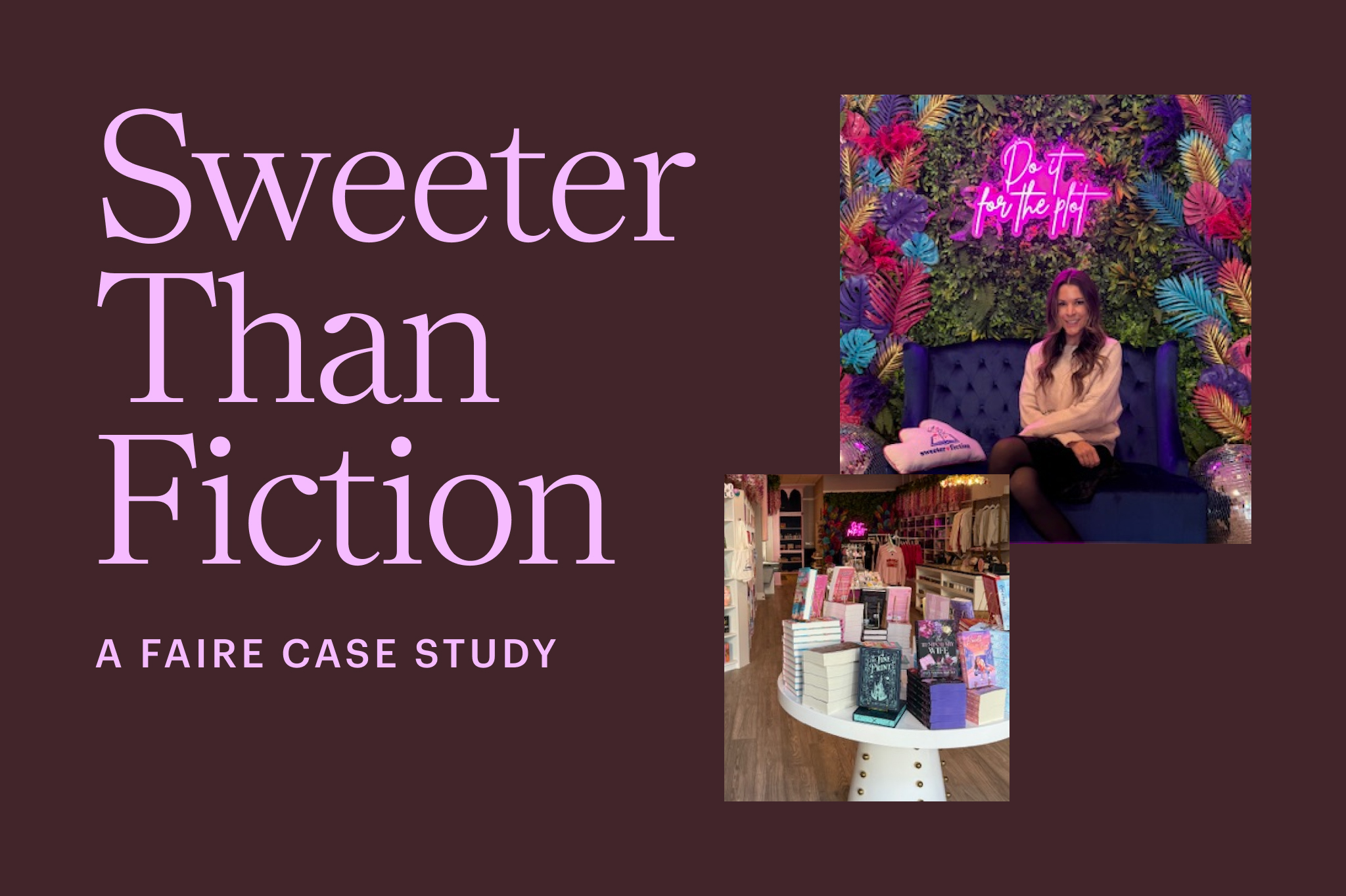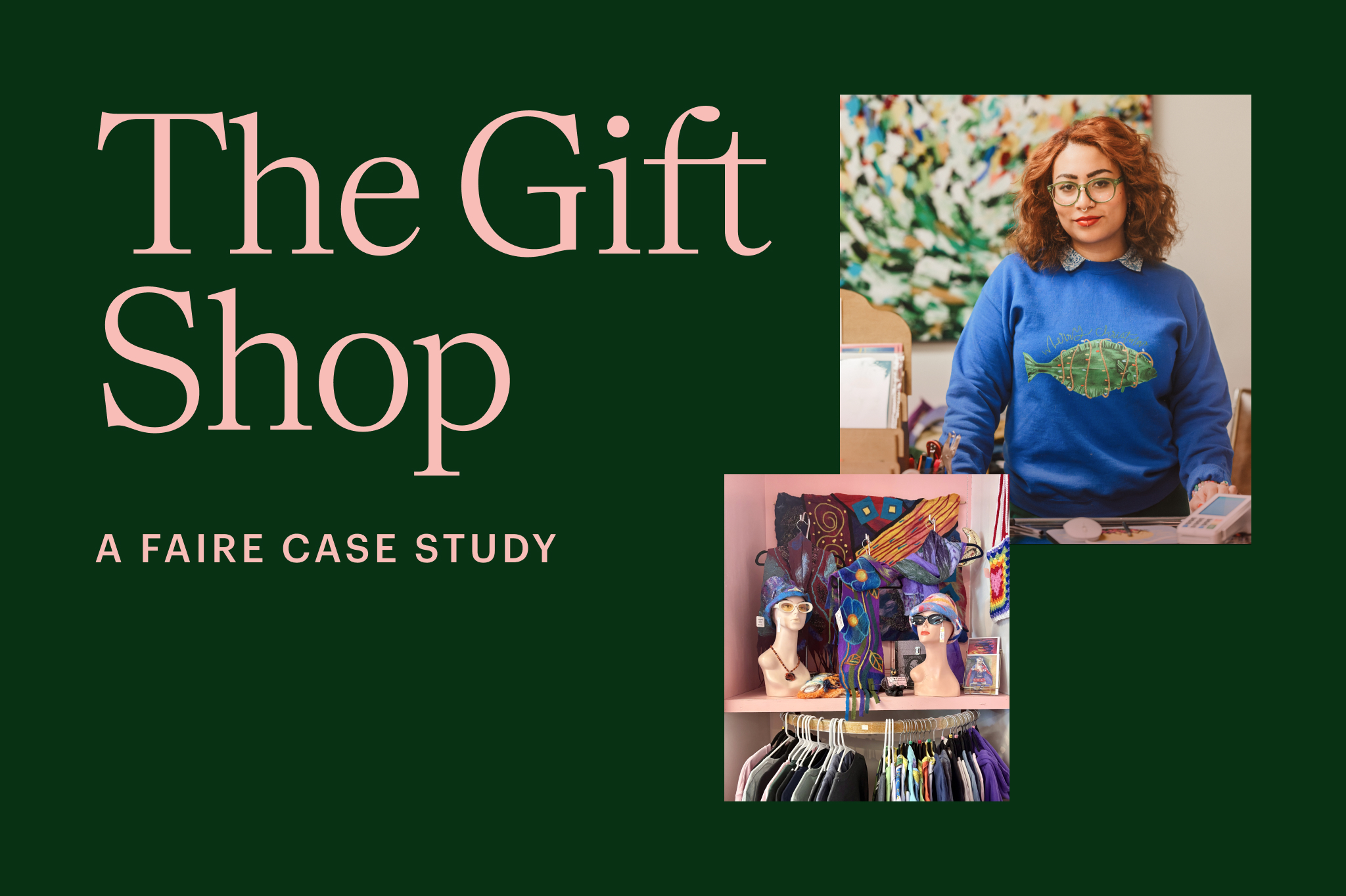

Need shelving inspiration for a new brick-and-mortar? Looking for tips to freshen up a retail space that’s feeling tired? We recently spoke with three Faire retailers who are experts in the art of curating eye-catching displays about how they create dynamic shelf layouts that drive sales.
Hackney Essentials is an East London–based specialist grocery and homewares shop that opened its doors in 2020 on the same day that the COVID-19 lockdown caused food essentials to be in short supply. Post.script. is a bright and colorful gift shop founded by a San Francisco native who grew up in the neighborhood where she opened her business. Brooklyn-based Tula House is a botanical experience and design company that started out as a plant truck in 2016. The unique visions that all three of these retailers brought to their respective stores keep customers coming back year after year.
post.script.
Post.script. founder Chandler Tang spoke with us about developing her business while working for a corporate beauty brand, how she creates the perfect shelf through trial and error, and her personal connection to San Francisco’s small-business community.
From office job to small-business ownership
Tang started post.script. while working a 9-to-5 in corporate beauty. She found herself dreaming of a project of her own and spent her nights developing ideas for a gift shop. Her late-night escape finally turned into a full-time business a couple of years ago. “I wear a lot of hats, but it’s been incredible to make the decisions and see their impact on the business,” she says.
While Tang admits it was scary starting out, she was sure to do plenty of research, get to know her customers and vendors, and reach out to fellow store owners to get firsthand help.
“Running a small business is a lot of work, but being a small-business owner is the most fulfilling work I’ve ever done,” Tang says.
Trial and error is the secret to a perfect shelf
A large table with stools underneath serves as the centerpiece of post.script.’s layout. “It mirrors a family table, like a classroom or community table,” Tang says. “So that was my huge pillar in the store—to have that kind of center harmony and circular energy.” She also has three clean, minimal, main shelves where customers can see and appreciate the products.
For Tang, the secret to building a great shelf is trial and error. “We’re constantly moving things around in the store, experimenting, and grouping different items together,” she says. “It’s incredible how you can group so many different items together to tell different stories.” Tang observes customers to see how they interact with products and tries to place items in a way that highlights certain qualities and selling points. For example, she might group together items that are made of the same material, such as brass, to create a home bar scene with tabletop items sharing a similar aesthetic.
The space inside post.script. is minimal, clean, and simple. Tang also likes to use pops of color to highlight different products around the shop. “We have a lot of bright and fun colors; it’s very playful,” she says. “A lot of our shelves and tables are very simple so that folks can really appreciate the product.”
Loving the San Francisco small-business community
As a San Francisco native, Tang says being part of the city’s small-business community means everything to her. “I’m from San Francisco, so I grew up here,” she says. “I took the bus in this neighborhood, and it’s been incredible to be a part of the community now as a small-business owner and give back.” She also comes from a family of small-business owners and is proud to carry on that tradition.
Tula House
We sat down with Christan Summers and Ivan Martinez—the husband-and-wife team behind Brooklyn-based Tula House—to talk about how they went from running a small plant truck to filling the shelves of a large brick-and-mortar space inspired by the warmth of a Cuban courtyard.
From plant truck to immersive botanical experience
When Summers and Martinez started their plant business in 2016, they managed to work wonders with the limited space of a former ice cream truck. “We retrofitted this funky truck into a beautiful greenhouse on wheels,” Summers says. The pair operated out of the truck for about three years before they opened their retail space. Now they describe their business as more than just a plant and design company, but rather as a botanical experience within a plant shop. “Beyond what you see here in the retail store, we also do a lot of plant design, installation, and maintenance around the city,” Summers says.
Summers got the idea to start Tula while working in advertising in New York City. Though she was happy with her job, city life sometimes made her feel disconnected from the natural world and from her roots. “I wanted to find something where I could put my business skills to work and that felt like I’m not adding more waste to the world,” she says. “If we can help people take care of plants, then perhaps they’ll take better care of the earth—it feels good.”
After spending a weekend in upstate New York with her husband back in 2016, she says she felt “that business itch” and knew she wanted to start a botanical business. “I saw this huge opportunity for education and retail—a different type of plant shop,” Summers says. “And then Martinez saw this great opportunity for a creative plant shop, a branded plant shop, and came up with these fun designs for the branding of Tula.” From there, the dream of a truly unique plant business became a reality.
Bringing a touch of Cuba to Greenpoint
Summers, who studied garden design, says she wants people to feel like they’re entering a new world when they walk into Tula House. “The inspiration is a Cuban courtyard,” she says. Discovery is also very important to the customer experience at Tula House. “I want them to have this incredible, overwhelming sense that they’re just about to discover and go on an adventure here where, especially in the arid room, there’s just so much that you’ve never seen.”
Martinez says they want Tula House to feel like “a different place” when customers walk in. “When you walk in, you can’t grasp the whole space in one view—you have to wind your way through the shop,” he says. “We want you to stay here, to look at things, to really discover it.”
Creating the perfect shelf through the customers’ eyes
For Summers, the key to the perfect shelf is looking through the customers’ eyes. “If I’m not going to buy that, why would somebody else?” she says. She also looks at the balance of texture and color, negative space, and whether you can “read a shelf” or if the objects are too close to each other.
The shelving itself is also an important consideration, Martinez says. “We wanted everything to be built into the walls, so there’s not much stuff bought off the rack,” he says. “We’re not just building the shelves and then plopping things on.” This means adjusting the height, positioning, and space for different plants rather than using a one-size-fits-all approach. He admits they didn’t always fill the space so intuitively as they were adjusting to the dimensions of an entire shop after working out of a small truck, but now they have the confidence to fill the space.
Liam Heeks, the store manager and plant buyer for Tula House, says there are many secrets to a good shelf. “We want to see customers engaging with our displays,” he says. “You want them to be able to touch something, feel it, maybe light a match and smell a candle. I also want my shelves to be inspirational—I want someone to want to take that experience that they’re looking at home with them.”
“I know I did a good job if I can’t stop looking at a display,” Heeks says.
The camaraderie of Brooklyn’s small-business community
Camaraderie is one of the best parts of the small-business community in Brooklyn for Summers, particularly in their neighborhood of Greenpoint. She loves how they all work together, help each other out, borrow each other’s tools, and have events together. Their customers also tend to live in the community. “People come in here a few times a week, and we know their names, we know their kids, we know their dogs,” she says. “In the world that we live in, that level of community is just so wonderful.”
Martinez says they’re lucky to be part of a community with so many small, family-owned businesses. “Everybody thinks of New York as this big, corporate place—and it is—but right here in Greenpoint, it’s small.”
Hackney Essentials
We spoke with the co-owner of Hackney Essentials, Corinne, about the origins of her business, her favorite kinds of merchandise, how to create the perfect shelf, and what she loves about being part of London’s small-business community.
The essential origins of Hackney Essentials
Corinne and her husband, Emrah, established Hackney Essentials in 2020 on the first day of the UK’s COVID-19 pandemic lockdown. They initially began as a food-essentials shop sourcing bread, coffee, fruit, and vegetables—“All the things that people were missing,” says Corinne.
Two years ago, they moved into their current space in a historic building on East London’s Columbia Road. “The shop has evolved over time,” says Corinne, who comes from an arts background. “Now we sell a broader range of artisan-produced food products and a really beautiful range of unusual wines, ceramics, and homewares.” One thing that’s remained consistent is their commitment to working with small producers and supporting makers who are committed to the values and aesthetics of their products. They also developed their own range of kitchen textiles in collaboration with East London designer Victoria Zuziak.
“One thing that we’ve particularly enjoyed since opening the shop and establishing relationships with producers is learning about the personal stories behind their products,” says Corinne.
Stocking long-lasting products
The team at Hackney Essentials is always on the lookout for new, interesting, thoughtful, and well-made products. “Our hope is that a customer will come in here and find something that they wouldn’t find in any of the big supermarkets,” Corinne says. “I like simple, well-made objects that people will keep for a long time, and I think in terms of sustainability.” They try to stock durable and beautiful items that customers will want to keep for decades, avoid products with plastic as much as they can, and don’t use plastic bags in their shop.
“We have to come in here and feel that the shop reflects our interests, our personality, our ethos, and our way of being in the world,” Corinne says. “We hope that customers feel there’s something to discover here—that there will be something unusual that they’ve not expected.”
Creating the perfect shelf
Since Hackney Essentials’ current location is in a historical building, Corinne says they allow the idiosyncrasies of the layout to determine how they design the store’s shelves and displays. “We’ve never read a manual on how to lay out a shelf or how you should place products,” she says. “The way that we lay out the shop is very intuitive—we think about how people move through the space.”
The shop may be small, but the Hackney Essentials team manages to pack in a lot of products without overstuffing the space. “When I’m laying out the shelves, I’m working in an intuitive way and thinking about color and form and practicality,” Corinne says. “Can somebody grab something? Can they hold it? Can they inspect it? Can they do that safely?” She also enjoys trying new things with the layout because sometimes it works and sometimes it doesn’t, but she can always keep moving things around to create the perfect look.
An act of resistance
“There’s a very tight-knit small-business community who support each other a lot,” Corinne says of East London. One of her favorite parts of that community is the strong relationships she’s been able to forge with members of the neighborhood.
But the best part about having her business is knowing that, despite the many challenges, she’s pushing through. “I actually see running a small business as an act of resistance,” Corinne says. “It’s quite difficult to run a small business at the moment. The climate’s very difficult. Prices have gone up. We all know what’s happening, kind of, with the economy. It’s not an easy moment. And so even when things are difficult, I feel I’m really, really pleased and proud of what we’re doing.”




